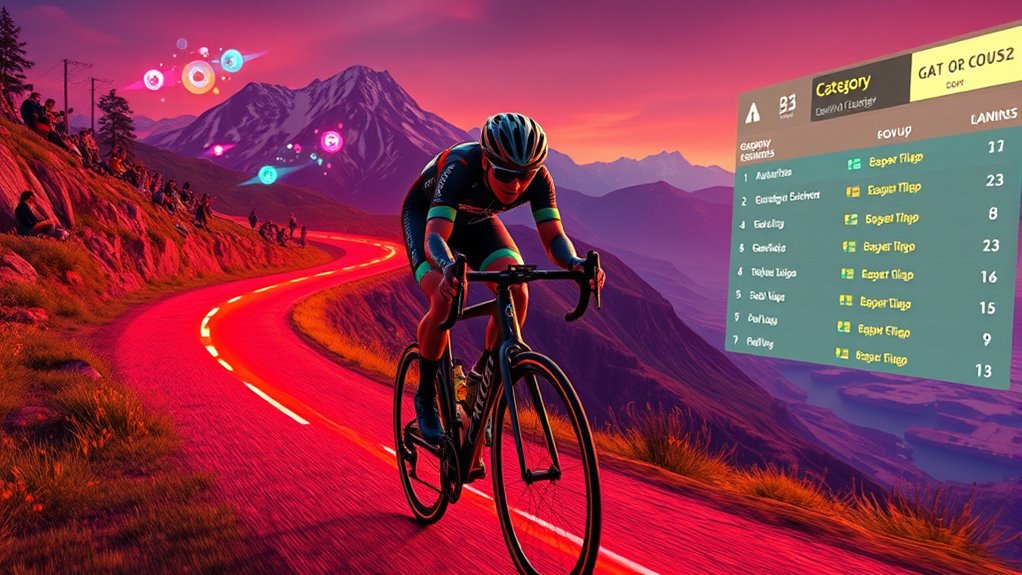In Zwift racing, you’re classified into categories A to D based on your FTP, helping you race appropriately and improve steadily. Power-ups give you tactical advantages, but timing is key—save them for climbs or breakaways to gain an edge. Smart tactics like drafting and pacing will keep you competitive and outmaneuver rivals. If you want to master these strategies and learn how to maximize your performance, there’s more to discover as you continue.
Key Takeaways
- Riders are categorized from A to D based on FTP, affecting race placement and competition level.
- Power-ups provide strategic advantages; timing their use during climbs or breakaways maximizes benefits.
- Drafting conserves energy and increases speed by reducing wind resistance.
- Effective tactics include anticipating attacks, pacing wisely, and responding proactively to competitors.
- Optimizing the indoor environment and monitoring performance data enhances focus and race strategy.
Understanding Race Categories and How They Classify Riders

To compete effectively in Zwift races, it’s important to understand how riders are classified into different categories. Gear classification plays a key role here, as it helps establish rider categories based on your functional threshold power (FTP), which measures your sustained effort capacity. Zwift sorts riders into categories from A to D, with A being the most advanced and D the newest or recreational riders. This classification guarantees fair racing, matching competitors of similar ability levels. Your gear classification reflects your FTP, and as your fitness improves, you can move up to higher categories. Recognizing these rider categories helps you gauge your skill level, set realistic goals, and race against opponents who match your current abilities, making every race more competitive and enjoyable. Additionally, understanding how training progress influences your category can motivate you to improve your performance over time, ensuring that you stay within your appropriate race category as your abilities develop. Maintaining awareness of resources and training options can also support your ongoing improvement and help you stay in the correct category.
Making the Most of Power-Ups During Your Races

Power-ups can give you a significant edge in Zwift races, turning the tide in tight moments or helping you conserve energy. To maximize their impact, focus on power-up timing—using them at the right moment can make all the difference. For example, deploying a boost during a steep climb or a critical breakaway can help you gain seconds or catch up to rivals. Effective boost management involves knowing when to save power-ups for strategic moments versus when to use them immediately. Avoid wasting them on minor hills or during low-intensity segments. Instead, plan ahead, anticipating key race moments where a well-timed power-up can accelerate your pace or provide recovery. Mastering power-up timing and boost management gives you a competitive edge that can help you finish stronger. Additionally, using a free online text capitalization tool can help you craft clear, impactful race strategies and communications. Understanding the contrast ratio of your setup can also help you better see your performance metrics and make real-time adjustments. Incorporating knowledge about Glycolic Acid benefits can inspire creative strategies for timing and execution, much like mastering classic game patterns.
Essential Tactics to Improve Your Performance and Outmaneuver Rivals

Improving your performance and outmaneuvering rivals in Zwift races requires strategic thinking and disciplined execution. Focus on effective drafting strategies to conserve energy and gain speed. Stay aware of your surroundings, anticipate attacks, and respond proactively. Psychological resilience is vital; stay calm under pressure and maintain confidence during critical moments. Use pacing to avoid burnout and keep a steady effort. Remember, small tactical moves can create advantages, so stay alert and adaptable. Additionally, understanding bedroom setup and environment can contribute to better focus and comfort during training and racing sessions. Optimizing your indoor training space can further enhance your readiness and mental focus, leading to improved consistency. Incorporating fraud prevention tools such as real-time monitoring and anomaly detection can ensure your training data remains secure and unaltered.
Conclusion
Mastering Zwift racing means understanding categories, leveraging power-ups, and applying smart tactics. Did you know that riders using strategic power-ups can improve their performance by up to 15%? By staying aware of your category and making tactical decisions, you’ll boost your chances of crossing the finish line ahead of the pack. Keep practicing, adapt your strategies, and enjoy the thrill of racing—your next victory is just a pedal stroke away.
















